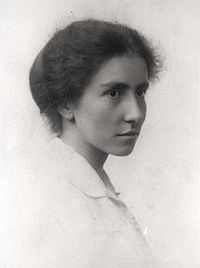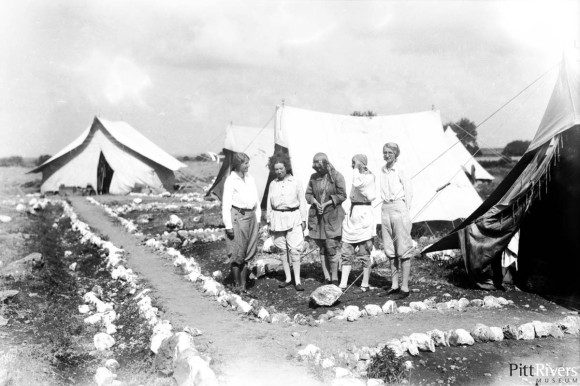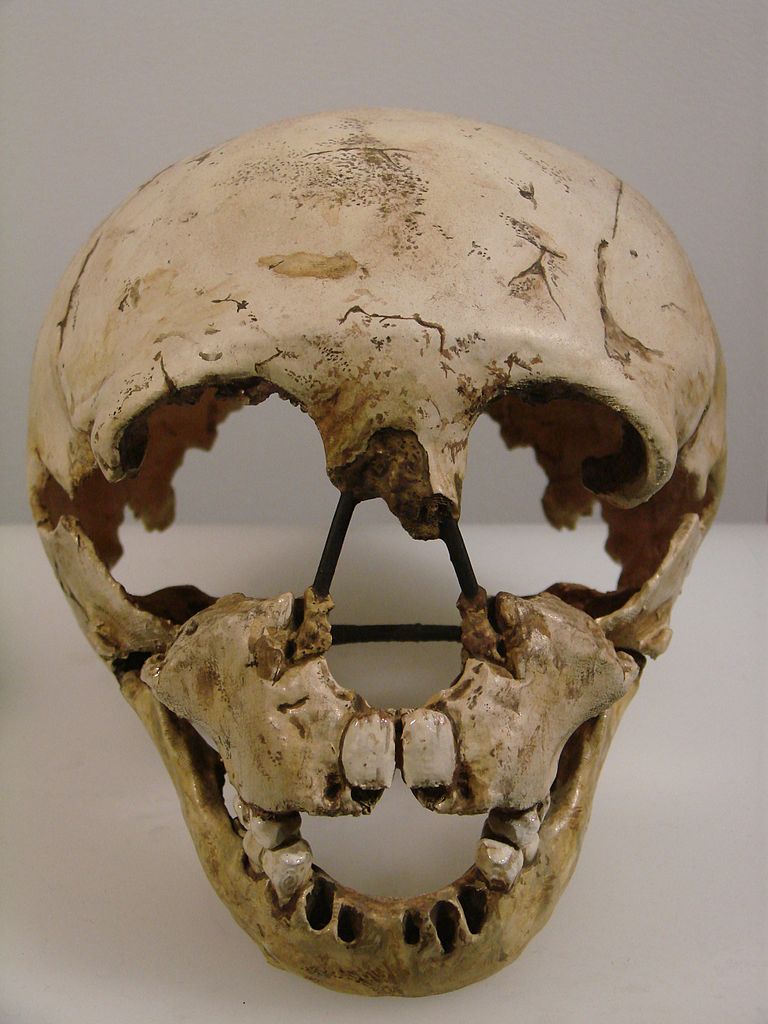Dorothy Garrod
Lizzie Pepper

Introduction
Dorothy Garrod is undoubtedly one of the most influential archaeologists of her time. She broke barriers again and again from how archaeology was done to who could do it. Many women in her time did not aspire to become prehistorians let alone travel the world to dangerous places to conduct research of early human origins. Her persistence to pursue archaeology as a pure science rather than just a pasttime for studying history brought about many changes to how archaeological research was performed. Her contributions to the archaeological community are truly unprecedented giving archaeologists the tools to continue their work in the present and the future.
Early Life
Dorothy Annie Elizabeth Garrod was born on May 5, 1892 in Melton, Suffolk. Garrod was the only daughter of four children born to Sir Archibald Edward Garrod and Laura Elisabeth. Her father was a physician and later became a professor of medicine at Oxford. Garrod was raised by a series of governesses who helped to educate her at home strongly in math, history, and Latin until she attended boarding school at Birklands School, St Albans. During the first world war two of Garrod’s brothers, Alfred and Thomas, as well as her (unofficial) fiancé lost their lives in battle. Shortly after these tragedies her youngest brother, Basil, died of influenza in 1919 before he was to also be demobilized (Adams). Garrod herself also served in the war with the Catholic Women’s League where she ended up in Malta while her father was the head of war hospitals. Garrod's life had become very dark and she was at a point where she needed to decide what to do with the rest of her life which would now fill this new void. At this time her father was the one to suggest that during this time she occupy herself with prehistoric antiquities. While in Malta she explored the ruins of the Stone Age agriculturalists and all of their successors who had built roads and temples there. The Garrod household with its many scientifically thinking members held a very methodical thinking process with demonstrated by a quote from her father who said to "restrain too eager flights of the imagination and too hasty conclusions" (Adams). These ideas strongly influenced Garrod's approach to the science of archaeology.
Academic Career
After gaining an interest in the study of prehistory Garrod decided to enroll in Newnham College, Cambridge where she was one of the few women to attend and earn a degree. Garrod graduated with a degree in History from Cambridge and when she returned to Britain she enrolled at Oxford University in 1921 where she gained distinction in pursuing an anthropology diploma. Much of her inspiration and skills that she gained from her time at Oxford came from her very influential mentor, Professor R.R. Marrett (The Editors of Encyclopedia Britannica). Marrett believed that the study of prehistory was “no longer an amateur past time but a true science in its own right” (Callander) . With her parents suffering the devastating loss of her brothers she made it her duty to make and make the family proud by achieving a life of intellect to follow in her father and grandfather’s footsteps. She did this by becoming a prehistorian studying the Old Stone Age with her main focus on human origin and the first seeds of agriculture (Adams). By association with Marrett, Garrod was able to meet many great historians of her time and see many things such as the painted caves at Count Bégouën’s house. Marrett was the one who introduced Garrod to the man who was most influential on her academic as well as archaeological career; Abbé Breuil. Breuil helped to educate Garrod and expand her knowledge about prehistory to a broader horizon than just the basics. Part of Garrod’s education was being able to identify stone tools by putting a bunch of them into a bag and telling her to reach her hand inside and identify them. After a while she was able to identify each one such as its chronology, date, and be able to identify its purpose and usage to create a context of the tool all by touch alone. Breuil took Garrod to see ancient decorated caves and paintings which were his specialty. She saw places such as Niaux and others where they would crawl on the ground and through the crevices to find the many wonders that these caves would possess; "bison modeled in clay, and portraits of sorcerers, and footsteps of Magdalenian man." (Adams). Exploring these caves was one of the main sparks that ignited Garrod's love for prehistory and early human origins.
Archaeological Career

Garrod's archaeological career was not like many others; for she faced many obstacles. As a woman, when she went to Cambridge she received recognition for her accomplishment through the anthropology program but was not recognized as a full time student so she could not obtain a degree just like all women at the time. What is most different about Garrod's work in comparison to others is how she did not see archaeology as a romanticized observation and discovery to a pure science that could be evaluated and tested with results for others to see. (Adams). For one of her first individual excavations she was advised to investigate Devil's Tower near Gibraltar where a Neanderthal skull from early human origins which had been discovered by none other than her mentor, Abbé Breuil. Five months into her excavation Garrod uncovered her own remains of a Neanderthal man in the context of a Mousterian industry and in a large residue of fauna (Murray). This accomplishment gained attention of other archaeologists beginning Garrod's establishment as an effective prehistorian in the field. Around the same time as this discovery another Neanderthal skull was discovered just off the coast of the Mediterranean near the Sea of Galilee. This discovery prompted archaeologists to begin searching for early human origin in more places than just Europe to toward the Middle East and Western Asia. And in the middle of all of it was Garrod who made a preliminary visit to the Kirkuk region of Iraq where she was able to find Mousterian remains that reached as far as northeast Iraq. With the help of a newly founded school that had the object of introducing American students to prehistory in the Old World, Garrod led an expedition into this region which contained the cave of Hazar Merd findings from this region not only confirmed that there was early human existence in this region but revealed that there was an Upper Paleolithic level that had not been previously known (Murray). The discovery of this child also led to research that helped to see what people at this time were eating and how they survived during this time (Fox). Between her excavation seasons Garrod looked for the first time to Palestine and the cave of Shukbah where she uncovered a microlithic industry that as covered in eroded breccia containing a Levalloiso-Mousterian industry. This discovery is what led Garrod to her excavation for which she would become most famous for, Mount Carmel.
The Mount Carmel project consisted of an excavation of three cave sites. Two of these three were excavated by Garrod her self while paleontologist Theodore McCown was appropriately in charge of the cemetery consisting of Neanderthal people. The most valuable outcome of the Mount Carmel excavations was the care taken in collecting and studying the animal and human remains that were uncovered. They were studied in great detail and documented closely and as accurately as possible. This is information was then made quickly available to other archaeologists and paleontologists who could use the information to further their own research (Murray). In addition to the Mount Carmel project, excavations were demonstrated through a long sequence of Lower Paleolithic, middle Paleolithic, and Epipaleolithic occupations in the caves of Tabun, El Wad, Es Skhul Shuqba, and Kebrara Cave. Garrod also conducted research in southern lebanon in 1958 which would be one of her last excavations continuing to learn more about the paleolithic era.
Major Contributions to Archaeology

Garrod was a different type of archaeologist than what had existed in the past. She was thorough and methodical in her work rather than simply making observations. She measured and recorded her finding and documented them into works that could be shared with other archaeologists to create a record for the Paleolithic time period (Adams). One of the ways she did this was by publishing her first book "The Upper Paleolithic Age in Britain" which took a lot of the information that she had uncovered about the paleolithic age and compiled it into a clearer picture of early human history. Garrod was very influential in the paleolithic context; she found the first pieces of evidence that demonstrated the mesolithic, or Middle Stone Age. She also found some of the earliest evidence for the domestication of dogs. Garrod's techniques for excavation were also what set her apart in the archaeological community. She was one of the first people to incorporate aerial photography into her excavations. Her career consisted of excavating over 23 sites in seven countries across two continents including: Britain, France, Gibraltar, Bulgaria, Anatolia, Palestine, Iraq and Lebanon. During Garrod's 45 years as a prehistoric archaeologist she was the first to extensively research early prehistory and lithic research. Garrod and Breuil were also the first archaeologists to look at archaeology from a global perspective rather than at a European scale. They were the ones to suggest that excavations should be carried out in Palestine, Lebanon and western Asia where Garrod was the first to find open-ai Mousterian sites in the Levant. Her findings from the excavations at Mount Carmel are also unprecedented. Garrod discovered that there were the presence of local forms who seemed to be indigenous to the area and had not been encountered in Europe. (Price). Through all of these discoveries Garrod was able to eliminate the ethnocentric European idea that all of the data of early human origins could be traced back to French data. However, as mentioned previously, Garrod was a part of the Roman Catholic community after she converted to Catholicism in 1913. This made a lot of her findings somewhat hard to deal with. The more she uncovered about the early human origins and early life the more that the time was inconsistent to the timeline of the Bible. For a little while she actually had to take a break from her work until she was able to come to peace with her religion and continue her research of prehistoric peoples. This was likely one of the first debates that her and her mentor Breuil had about creationist and evolutionary points of view. It has been said that the archaeological record would not be nearly as complete without the work of Garrod and her excavations in the Middle East and Western Asia. In her writings Kathryn Price said "it is impossible to imagine what the archaeological record would have looked like had Dorothy Garrod not excavated Mount Carmel" (Price).
Her Legacy
Without the work of Dorothy Garrod archaeology would be a very different picture than what it is today. Garrod's work allowed archaeologists during and after her lifetime to continue her work and uncover information about the paleolithic era and early human origins. Garrod's work also broke through the barriers of women in the archaeological field. She became the first woman professor at the University of Cambridge and her crews on excavations almost always included either all women or a majority of women (Birch). . During the Mount Carmel expedition her team consisted of entirely all Arab females because she said that they were hard workers and the money she paid them went directly to the needs of their families. Garrod's faith and kind-heartedness combined with her scientific ability to analyze her data and research is what truly set her apart from any other archaeologist in the field at the time. She was kind to others but also would not rest until she was able to get the information that she needed from her excavations. In 1968 she was the first woman to be awarded the Gold Medal by the Society of Antiquaries in London. In addition to her belief of a global archaeological record Garrod felt it was important that young archaeologists were given the opportunity to travel and visit worldwide excavation sites, so Garrod began the "Dorothy Garrod Travel Fund" which allows students to travel around the world and still exists today (Price). Dorothy Garrod was a true pioneer in the field of archaeology making way for women and developing the field into a true science that can be shared and developed for years to come.

